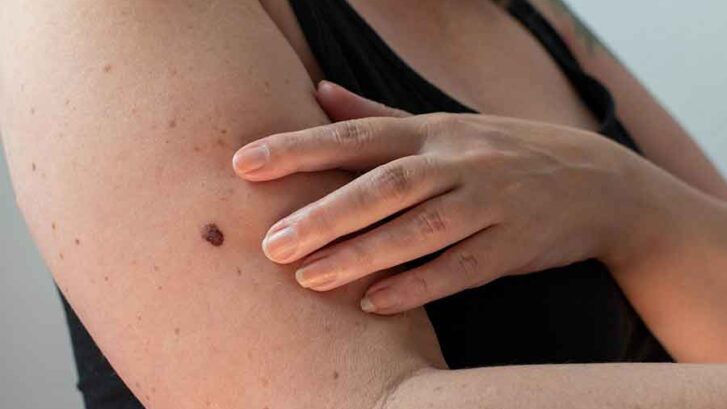Surprising Facts About Skin Cancer
You may think you already know everything about skin cancer. But because May is Skin Cancer Awareness Month, our concierge primary care doctors in Jupiter want to share some facts about this often-deadly disease that you may not be aware of.
Brief Skin Cancer Recap
Let’s start with some facts about skin cancer you may already know:
- Basal cell carcinoma is the most common form of skin cancer, followed by squamous cell carcinoma. Both can easily be cured if caught in time, but they can be disfiguring and expensive to treat.
- Malignant melanoma is the most deadly type of skin cancer. It represents only about three percent of all skin cancers diagnosed but is responsible for the most deaths. That’s because of its tendency to spread to other parts of the body, including vital organs. But when diagnosed early, its five-year survival rate is 99 percent.
- The most preventable cause of skin cancer is exposure to ultraviolet (UV) light, either from the sun or from artificial sources like tanning beds.
- About 90 percent of non-melanoma skin cancers and 85 percent of melanoma cases are associated with exposure to UV radiation.
- One bad sunburn in childhood doubles the risk for melanoma later in life. Having five or more sunburns doubles your risk for melanoma. A single indoor tanning session increases your risk of melanoma by 20 percent.
- Even if it’s cool and cloudy, you still need protection, because ultraviolet (UV) light can penetrate clouds.
Odd Skin Cancer Facts
There are other facts about skin cancer that you might never have heard before.
1. For example, did you know that more men than women die of melanoma? The American Academy of Dermatology (AAD) says that one reason may be that men know less than women about skin cancer and that they use sunscreen less than women do.
Men’s skin is also more prone to penetration by UV rays than women’s because they have thicker skin with less fat beneath. A man’s skin also contains more collagen and elastin, making men’s skin more likely to be damaged by UV light.
2. On the other hand, one study found a greater association between white wine consumption and a higher risk of melanoma in women. Those who drink a glass of white wine each day showed a 13 percent increased risk of invasive melanoma (meaning it’s gone deeper than the top layer of skin), while those who drank the most white wine had an increased risk of 50 percent or higher than those who don’t drink any alcohol.
3. UV rays can penetrate glass in windows, both at home and in the car. This helps explain why left-sided facial cancers, especially in men, are more common. It’s all about the position we drive in, with the left side of the body exposed to more UV light. Windshields are treated to block UV rays, but side, back and sunroof windows aren’t. Also, be aware that UV rays can not only penetrate glass, but also can “bounce” under beach umbrellas and reflect off of concrete surfaces.
4. It’s extremely rare for a mole to transform into a melanoma, according to Dr. Ashfaq Marghoob, a dermatologist with the Memorial Sloan Kettering Cancer Center. While melanoma can develop in a preexisting mole, nearly 70 percent do not. At the same time, the presence of many moles can identify those who are at an increased risk for developing melanoma somewhere else on their skin.
That’s why it’s important to apply sunscreen to all parts of the body.
“Some people use sunblock only where they have moles because they think the moles themselves are dangerous,” he says.
5. Caffeine may protect against skin cancer. One study found that women who drank more than three cups of coffee daily were 21 percent less likely to develop basal cell carcinoma (BCC), the most common type of skin cancer. Men were 10 percent less likely to develop BCC.
6. Melanomas are not necessarily brown. Some have no color or are pink or appear as simple bumps on the skin. That’s why it’s important not to try to diagnose skin cancer on your own.
“Be aware of isolated or pink spots, especially if the spot looks different than any other marks on the skin,” Marghoob says. “Pay attention to any spot or mark that has an uneven texture, shape, border, or distribution of colors,” he added. “In addition, any spot that has changed in some way should prompt a visit to your doctor.”
Avoiding Skin Cancer
To avoid getting skin cancer, the most common cancer in the U.S. and around the world, the AAD recommends these steps.
- Seek shade. The sun’s rays are strongest between 10 a.m. and 2 p.m. If your shadow appears to be shorter than you are, stay in the shade as much as possible.
- Wear sun-protective clothing, such as a lightweight long-sleeved shirt, pants, a wide-brimmed hat, and sunglasses with UV protection. For more effective protection, choose clothing with an ultraviolet protection factor (UPF) number on the label.
- Apply a broad-spectrum, water-resistant sunscreen with an SPF of 30 or higher to all skin not covered by clothing. Broad-spectrum sunscreen provides protection from both UVA and UVB rays.
If you have any questions about how to protect yourself from the sun or notice new or suspicious spots on your skin or any spots that are changing, itching, or bleeding, let us know.

